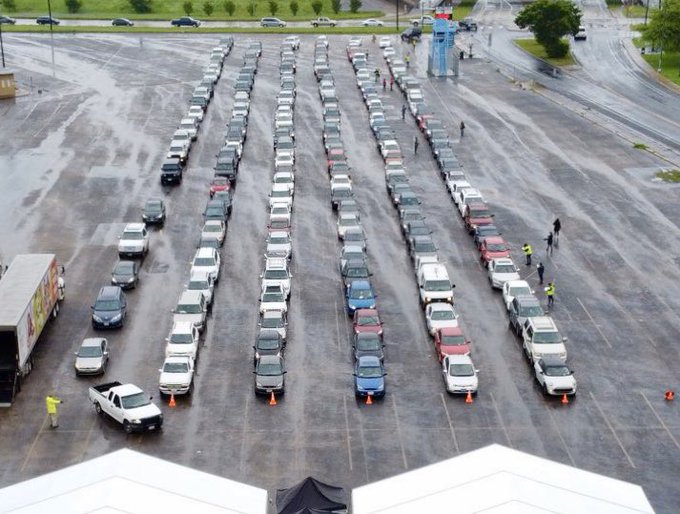The Coronavirus Food Bank Crisis Is Already Underway
In Austin and across the country, service providers are dealing with spikes in demand, new logistical challenges, and mounting uncertainty about the months ahead.

On a rainy Saturday morning in Austin, Texas, the cars lined up in six neat rows, waiting in the parking lot of a high school stadium for two boxes of groceries from the Central Texas Food Bank. For more than three hours, volunteers wearing gloves and masks hustled supplies from a pair of large white tents out to open trunks and truck beds, eliminating the need for risky person-to-person handoffs that would run afoul of six-foot social distancing requirements.
It is a scene playing out with increasing frequency across the country, as COVID-19 forces food assistance organizations to manage dwindling inventories, shrinking volunteer bases, and increasingly onerous restrictions on business as usual. Aerial footage from Pittsburgh shows hundreds of cars snaking along the road, waiting to access a food bank where usage has increased 543 percent since the pandemic began. Last week, the San Antonio Food Bank served 4,000 families at a pair of mass distribution events; at one, cars began lining up at midnight for a giveaway scheduled to begin at 10 a.m., according to the San Antonio Express-News.
The Central Texas Food Bank, which serves a 21-county area about twice the size of the state of Massachusetts, is seeing spikes in demand of between 40 and 300 percent depending on the location, says Paul Gaither, the organization’s director of marketing and communications. Those higher-end numbers are mostly in the heavily-populated Austin area, where layoffs and hours reductions are forcing many people to reach out for emergency help for the first time. A recent national Guardian investigation found that as jobs disappear and unemployment claims skyrocket, about one in three people coming to food banks have not used one before.
The food bank is exempt from Austin’s shelter-in-place order, which took effect just before midnight on March 25. But like many organizations that provide services to lower-income and unhoused families, it has had to overhaul its operations in response to the crisis, implementing new transmission prevention protocols and serving more clients with fewer staffers and volunteers.
“Most pantries that we supply food to are what’s called ‘client choice’—people can come in and make their own choices, bag and box their food, and take it home,” Gaither says. “That requires a certain amount of human interaction, and we’re trying to minimize that.” Now, the food bank is only distributing groceries in pre-packed boxes, on a drive-through basis or using a no-touch drop-and-grab system. Each of the 1,515 families that showed up on Saturday took home about 50 pounds of food apiece: One box filled with nonperishable items like peanut butter and canned tuna, and another with bread, frozen chicken, and other kitchen staples.
The inability to allow clients to shop for themselves creates novel logistical challenges at a time when meeting even basic needs is difficult: Now, the task of distributing food involves finding sites, providing security and traffic control, setting up infrastructure, and assembling the boxes before each event. Under normal circumstances, a volunteer shift at the food bank’s main facility can consist of up to 120 people; now, it’s down to about a third of that figure. Start and stop times are staggered to cut down on congregating in the lobby, and as of today, the food bank is requiring volunteers to wear face masks, too.
At a time when panicked shoppers are leaving some grocery shelves bare, the Central Texas Food Bank is seeing a drop in donations from its usual institutional donors, and is asking for monetary donations to give it the flexibility to respond to unexpected shortfalls as they arise. “It isn’t like a certain region was hit by a hurricane, and things can flood in from across the country,” Gaither said. “Everybody is affected by this.”
In response to the looming crisis, the City Council will consider legislation this week to create a $15 million coronavirus emergency fund, without about half that amount earmarked for direct financial aid and the other half for organizations that provide in-kind assistance. The money would come from the city’s existing rainy-day budget reserves, and Councilmember Gregorio Casar told The Appeal he expects the move to be the first of several to help tens of thousands of families make ends meet.
The fund would supplement the relatively paltry means-tested stimulus payouts from the federal government, which have drawn fierce criticism for making relief unavailable to many especially vulnerable people. Lower-income seniors and sporadically-employed individuals, for example, may not qualify to receive either regular unemployment or special federal assistance. “My district is overwhelmingly working-class people who work with their hands,” Casar said. “Those folks are at increased risk of spreading the virus, getting the virus, and not having access to food or not being able to pay the rent.”
Some of this spending could eventually prove eligible for reimbursement by the federal government, Casar told The Appeal. But as the pandemic worsens and the need for a more robust social safety net becomes clearer, the city simply can’t afford to wait any longer. “There’s already a line of hundreds of cars at the high school,” he said. “There’s already people who have gone weeks without a paycheck.”
